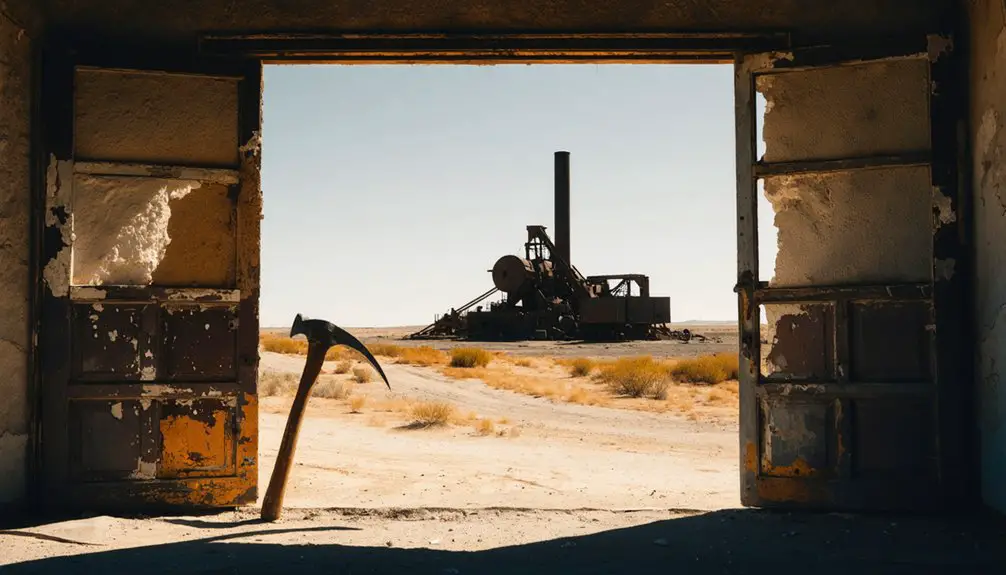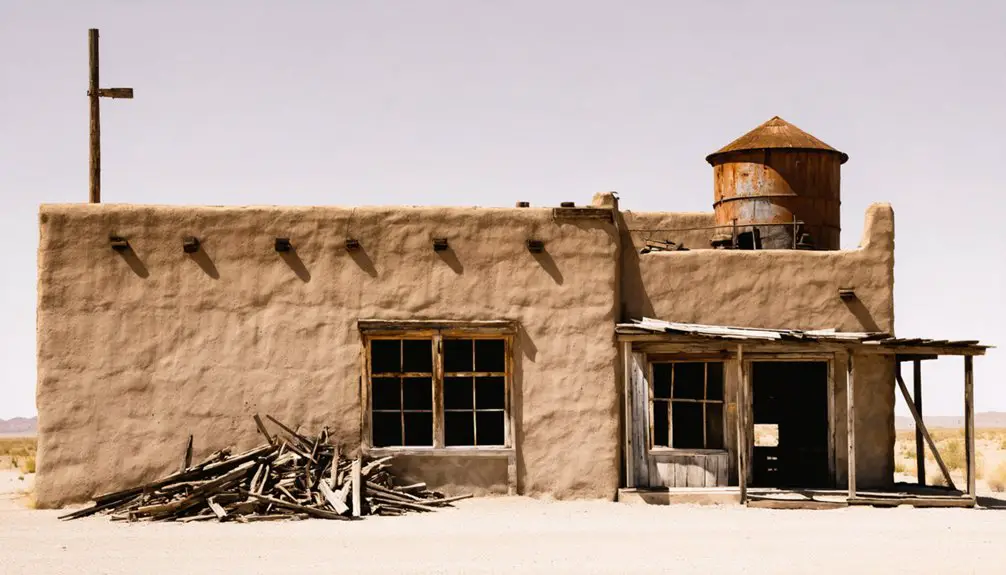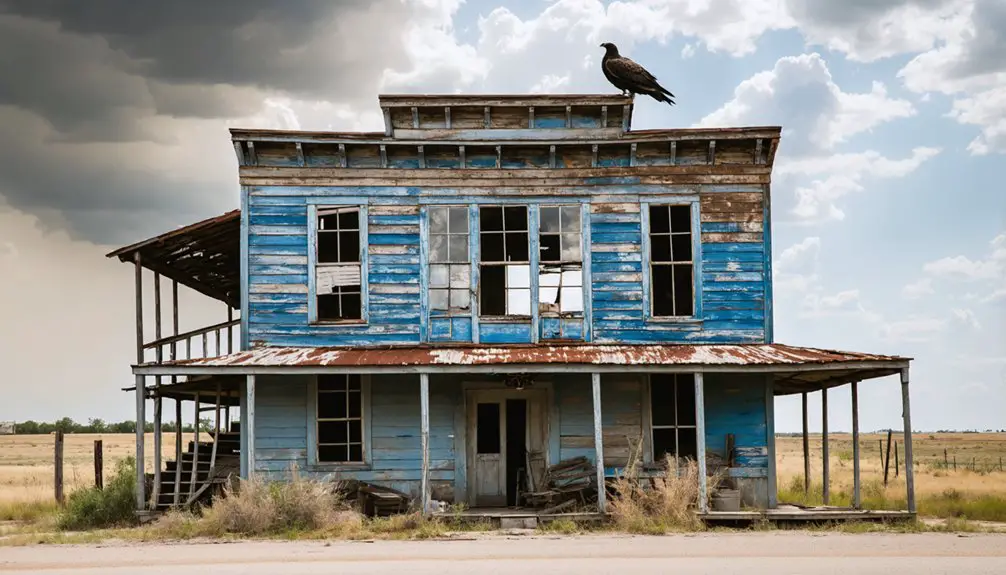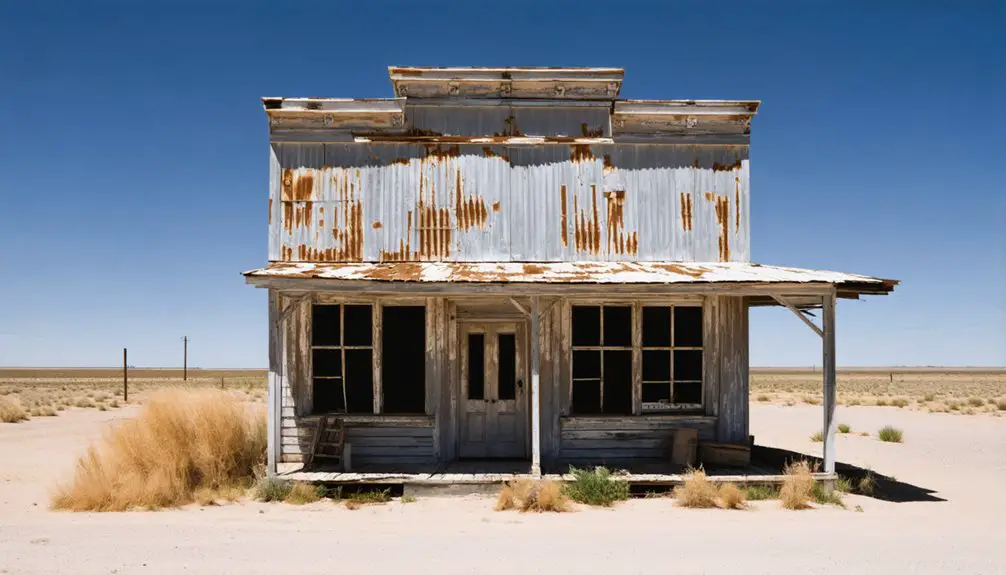You’ll find Darwin, Texas at the confluence of the Rio Grande and Santo Tomas Creek, where it began as a coal mining town in 1882. Named after David Darwin Davis of the Cannel Coal Company, the town quickly grew to over 1,000 residents by 1900. Miners earned 50-85 cents for grueling ten-hour shifts in dangerous conditions. After mining operations ceased in 1939, Darwin’s population plummeted to 75, leaving behind only its cemetery and countless untold stories.
Key Takeaways
- Darwin was established as a Texas mining town in 1882, reaching its peak population of 1,039 by 1900 through coal operations.
- The town relied heavily on immigrant Mexican labor, with workers earning 50-85 cents for ten-hour shifts in harsh conditions.
- Mining operations included vertical shafts up to 140 feet deep, with coal transported via river barges and later by railroad.
- By 1939, mining operations ceased completely, causing the town’s population to plummet to 75 before total abandonment.
- Today, only the cemetery remains as evidence of Darwin’s existence, with all other structures having disappeared by 1939.
Origins of a Mining Frontier
While coal discoveries sparked many frontier settlements in Texas, Darwin emerged in 1882 as a distinctive mining town at the confluence of the Rio Grande and Santo Tomas Creek.
Much like the disambiguation title that shares its name, the town’s historical significance spans multiple contexts and meanings.
You’ll find that the town’s origins trace back to David Darwin Davis, who owned and superintended the Cannel Coal Company that would shape the community’s destiny.
Initially called “Cannel” after the type of coal found there, the settlement’s coal discovery quickly transformed the frontier landscape.
The town experienced rapid growth, reaching a population of 1,039 by 1900 as mining operations expanded.
The Rise of Coal Mining Operations
You’ll find Darwin’s early mining operations were equipped with vertical shafts and underground tunnels reaching 140 feet below the surface, where miners extracted valuable cannel coal.
Under superintendent David Darwin Davis’s leadership, the Cannel Coal Company established strict workplace policies, including mandatory health care deductions and company-controlled housing arrangements. Local miners came from diverse backgrounds, with eighteen different nationalities represented in the workforce.
Workers earned between fifty to eighty-five cents for grueling ten-hour shifts, living in modest two-room houses while battling widespread diseases like tuberculosis. The coal was transported via river barges until railroads were constructed in the area.
Mining Equipment and Technology
The early coal mining operations in Darwin relied primarily on manual labor and basic hand tools before the advent of mechanization.
You’d find miners accessing coal seams through vertical shafts and sloped adits, where they’d blast and load ore carts by hand. Mining innovations were limited – small gasoline locomotives helped transport coal within mines, though most hauling still depended on manual labor or mules. Most mines remained relatively small, producing 10,000 to 50,000 tons annually for local consumption.
The Texas and Pacific Coal Company took control of operations to meet growing railroad demand. As mining technology evolved, you’d see the development of longwall and pillar-and-stall methods to maximize coal extraction.
Safety advancements were minimal, with miners working long hours in hazardous conditions with poor ventilation and dust control.
Company Leadership and Management
Since establishing Darwin in 1882, David Darwin Davis shaped the town’s early mining industry as owner and superintendent of the Cannel Coal Company. The leadership dynamics extended beyond Davis, with former Colorado governor Alexander Cameron Hunt joining efforts to expand coal mining operations in Webb County.
You’ll find that management practices were strictly hierarchical and controlling, with company leaders overseeing both mining operations and retail businesses in a vertically integrated structure.
The town’s management maintained tight control through company-owned housing, stores, and healthcare systems. They’d deduct rent and medical expenses directly from miners’ wages, which typically ranged from fifty to eighty-five cents for ten hours of work. The managers transported coal to market using steam-driven barges and mule-drawn wagons.
Leadership focused on maximizing coal output while controlling labor costs, employing mostly young Mexican immigrants under harsh conditions.
Worker Pay and Conditions
Mining operations in Darwin relied heavily on immigrant Mexican laborers, who formed the backbone of the workforce during the town’s peak years from the late 1800s to early 1900s.
You’d find these miners, mostly in their 20s and 30s, working grueling shifts from dawn till midnight in dangerous underground conditions.
The wage disparities were stark – workers earned only 50 to 85 cents for ten hours of backbreaking labor. Labor exploitation was evident in the company’s practice of deducting 20 cents monthly for medicine and $1.75 for rent from their meager earnings.
Since pay depended on coal volume extracted, miners often pushed themselves to work longer hours.
Living conditions weren’t much better, with families cramped into small two-room frame houses while battling widespread health issues due to poor sanitation and hazardous working environments.
The miners primarily extracted cannel coal using horizontal shafts near the Rio Grande banks.
Life in a Texas Coal Town
During the early 1900s, life in Texas coal towns like Darwin centered around tight-knit communities of up to 2,000 residents, where company-controlled housing and amenities shaped daily existence.
You’d find yourself living in modest housing near the mines, with your social life revolving around community gatherings at local churches, dance halls, and bandstands. These social venues provided essential relief from the demanding mining schedule. Miners endured grueling twelve-hour workdays from early morning until evening.
Your children would attend the local school alongside other miners’ families, while you’d shop at company stores and rely on basic company-provided utilities. With up to 500 workers employed at the mines, the town hummed with constant activity.
If you needed serious medical care, you’d have to travel to larger towns nearby. Life wasn’t easy, but the shared experience of mining work, religious services, and communal activities created strong bonds among residents despite the challenging conditions.
Working Conditions and Labor History

As laborers descended into Darwin’s coal mines each day, they faced grueling ten-hour shifts that paid only 50 to 85 cents, with mandatory deductions for rent and basic healthcare eating into their meager earnings.
You’d find miners working from dawn until midnight, desperately trying to support their families through productivity-based wages.
The fight for labor rights intensified as workers battled dangerous working conditions, including roof collapses and gas explosions.
You’d see miners lying flat to extract coal from thin veins, using risky explosives while battling widespread tuberculosis.
The United Mine Workers of America championed their cause, leading strikes that often turned violent.
Their struggles weren’t in vain – the UMWA’s efforts eventually secured the eight-hour workday, though not before countless lives were lost to unsafe conditions and company exploitation.
Population Growth and Demographics
The small Texas town of Darwin reached its peak population of 1,039 residents by June 1900, a direct result of the same coal mining operations that had brought such harsh working conditions to the area.
One-third of the population consisted of young Mexican immigrant men who’d ventured north seeking mining work, greatly shaping the town’s demographic makeup.
Population shifts occurred rapidly as Darwin’s fortunes changed. You’d find miners and their families living in modest two-room frame houses, with some workers as young as thirteen joining the labor force.
The immigrant experiences of these mainly male workers reflected the broader patterns of Mexican migration to U.S. mining towns.
The Built Environment and Infrastructure

In Darwin’s built environment, you’ll find a coal mining town established in 1882 with utilitarian structures clustered near the mines and Rio Grande for efficient transport access.
You’d have seen miners living in small two-room frame houses while working among the mines, ore carts, and rail facilities that formed the town’s industrial backbone.
The Rio Grande and Eagle Pass Railroad served as Darwin’s essential transportation link, though by 1939 most structures had vanished, leaving only the cemetery as evidence of the once-bustling mining community.
Mining Structures and Equipment
Mining operations in Darwin centered around multiple shaft entrances and hillside adits, supported by extensive processing facilities and equipment.
You’ll find mining ruins scattered across the landscape, with the Defiant Smelter‘s remains standing as a symbol of the site’s industrial archaeology.
The mining infrastructure included:
- Processing facilities with binding machinery and ore crushers near the mill sites
- Smelting equipment used for metal extraction from raw ore
- Rail transport systems with ore carts connecting to the Rio Grande railroad
- Support buildings including Kwansei huts and maintenance garages
The site’s equipment reflected the era’s mining technology, from basic hand tools to complex mechanical systems for ventilation and water pumping.
Housing and Living Quarters
Residential life in Darwin centered around four distinct housing types that supported the coal mining workforce.
You’ll find remnants of modest wooden frame houses that were typical of late 19th and early 20th century mining towns, alongside more durable structures built from locally-sourced clay bricks. These housing styles prioritized function over form, meeting immediate shelter needs for workers.
Living conditions improved with the town’s growth, as homes incorporated modern amenities like electricity and indoor plumbing – luxuries rare in rural areas of that era.
The community’s layout featured residential zones strategically placed near mines and transportation lines, with barbed wire fencing marking property boundaries.
Today, most of these structures lie in ruins, with only foundations and a few intact buildings remaining as evidence of Darwin’s mining heritage.
Transportation Access Points
While Darwin’s strategic location near the Rio Grande initially attracted settlers, it was the Rio Grande and Eagle Pass Railroad that transformed the town into an important coal transport hub in the late 19th century.
The town’s key transportation routes included:
- The railroad line, which served as the primary artery for coal shipments to South Texas markets
- Farm Road 1472, providing local road access for mine workers and residents
- The Rio Grande and Santo Tomas Creek confluence, influencing early settlement patterns
- Fenced access points that controlled movement in and out of the company town
You’ll find that accessibility challenges mounted after the mines closed in 1939.
The railroad ceased operations, roads fell into disrepair, and the once-bustling transport infrastructure deteriorated.
Today, only scattered ruins mark where Darwin’s crucial transportation network once stood.
Economic Challenges and Decline

As coal emerged as the economic foundation of Darwin in 1882, the town’s fortunes became inextricably linked to the mining industry’s boom-and-bust cycle.
You’d have witnessed the population surge to 800 by 1914, driven by mining operations and railroad connections. Yet this economic dependency proved fatal when combined with exploitative company practices.
You’d have found miners struggling under a restrictive scrip system, forced to shop at company stores while earning low wages. This spawned labor unrest by 1888, with strikes reflecting growing worker discontent.
When mining profitability declined and operations ceased in 1939, Darwin’s economy collapsed. Without alternative industries to sustain it, the town’s population plummeted to 75 before complete abandonment.
Like many single-industry towns, Darwin couldn’t survive once its economic lifeline vanished.
Legacy and Historical Preservation
Despite Darwin’s complete abandonment after 1939, several physical remnants testify to its coal mining past.
Today, you’ll find the Darwin Cemetery as the most prominent historical marker, showcasing the town’s rich cultural heritage and immigrant influence through its weathered headstones and iron fencing.
The town’s legacy lives on through:
- Preserved brickwork from skilled immigrant craftsmen, particularly Polish masons
- Mine dumps and scattered industrial remnants that reveal the site’s coal mining operations
- Historical markers documenting the diverse workforce of Polish, Italian, British, Irish, and Mexican miners
- Cemetery memorials and oral histories that keep the multicultural stories of Darwin’s mining community alive
While large-scale preservation efforts haven’t materialized, these remaining features continue to tell the story of Darwin’s industrial past and its immigrant workers’ contributions.
Frequently Asked Questions
Are There Any Remaining Structures or Ruins Still Visible in Darwin Today?
You won’t find any documented remaining structures or visible ruins in Darwin today. Historical records and current site conditions suggest any traces have deteriorated beyond recognition or disappeared entirely.
What Role Did Women Play in Darwin’s Mining Community?
Like modern-day multitaskers, women’s contributions were crucial, serving as ore processors and prospectors while providing essential community support through teaching, healthcare, boarding houses, and social organization in the mining operations.
Did Any Major Accidents or Disasters Occur in Darwin’s Coal Mines?
You won’t find any documented major accidents in these mines. Historical records don’t show significant disasters, though it’s worth noting mine safety standards weren’t as developed during Darwin’s operating years.
Were There Any Schools or Churches Established During Darwin’s Peak Period?
While you’d expect community pillars like school history and church significance in a town of 800, there’s no documented evidence of either institution during Darwin’s peak period from the 1880s through 1915.
What Happened to the Residents After Darwin Became a Ghost Town?
You’ll find most residents’ journeys led them to nearby towns like Dolores and Laredo seeking work, while a few stayed behind, preserving Darwin’s legacy through cemetery maintenance and oral histories.
References
- https://pinintheatlas.com/travel-blogs/darwin-ghost-town/
- https://mix941kmxj.com/the-strange-sad-story-of-a-texas-ghost-town-youll-never-visit/
- https://www.texasalmanac.com/places/darwin-0
- https://www.youtube.com/watch?v=phjUE19A8HM
- https://en.wikipedia.org/wiki/List_of_ghost_towns_in_Texas
- https://kids.kiddle.co/Darwin
- https://www.tshaonline.org/handbook/entries/darwin-tx
- https://photobasecamp.com/location-darwin-ghost-town-ca/
- http://www.owensvalleyhistory.com/stories/cuppett_darwin_1979.pdf
- https://en.wikipedia.org/wiki/Darwin



